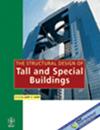Improving the behavior of concentrically braced frame braces using a flexural damper: Experimental and numerical study
IF 1.3
3区 工程技术
Q3 CONSTRUCTION & BUILDING TECHNOLOGY
引用次数: 0
Abstract
Summary Although the concentrically braced frames (CBFs) systems have high lateral elastic stiffness and strength, they reflect a low seismic energy absorption capacity mainly due to their diagonal buckling under compressive loading. To overcome this problem, researchers have proposed metallic shear damper as the most popular due to its satisfactory performance and affordable cost. In this paper, an innovative metallic damper with a flexural mechanism is proposed to improve the behavior of CBF systems. It provides ease of fabrication and replacement after damage, competitive cost, and improved resistance to buckling of the CBF member. The performance of the damper was evaluated experimentally and numerically. Subsequently, two types of dampers, (a) made of rectangular flexural plates (RFP) and (b) made of I‐shaped flexural plates (IFP), were designed and evaluated. Experimental as well as numerical results indicated that both dampers provide stable and symmetrical hysteresis curves with a high energy absorption capacity. Results indicated that the IFP damper has greater stiffness (1.94–2.3 times) and ultimate strength (1.76 times) but a lower overstrength (66% less) and ductility (47% less) than the RFP damper. Moreover, design expressions were presented for the proposed damper and showed a good agreement with finite element results.使用弯曲阻尼器改善同心支撑框架支撑的性能:实验和数值研究
虽然同心支撑框架(CBFs)体系具有较高的横向弹性刚度和强度,但主要由于其在压缩荷载下的对角屈曲,反映出较低的地震能量吸收能力。为了克服这一问题,研究人员提出金属剪切阻尼器是最受欢迎的,因为它具有令人满意的性能和负担得起的成本。本文提出了一种具有弯曲机构的新型金属阻尼器,以改善CBF系统的性能。它易于制造和损坏后更换,具有竞争力的成本,并提高了CBF构件的抗屈曲能力。对阻尼器的性能进行了实验和数值评价。随后,设计并评估了两种类型的阻尼器,(a)矩形弯曲板(RFP)和(b) I形弯曲板(IFP)。实验和数值结果表明,两种阻尼器均提供稳定对称的滞回曲线,具有较高的能量吸收能力。结果表明,与RFP阻尼器相比,IFP阻尼器具有更高的刚度(1.94 ~ 2.3倍)和极限强度(1.76倍),但其超强度(低66%)和延性(低47%)较低。给出了该阻尼器的设计表达式,与有限元计算结果吻合较好。
本文章由计算机程序翻译,如有差异,请以英文原文为准。
求助全文
约1分钟内获得全文
求助全文
来源期刊
CiteScore
5.30
自引率
4.20%
发文量
83
审稿时长
6-12 weeks
期刊介绍:
The Structural Design of Tall and Special Buildings provides structural engineers and contractors with a detailed written presentation of innovative structural engineering and construction practices for tall and special buildings. It also presents applied research on new materials or analysis methods that can directly benefit structural engineers involved in the design of tall and special buildings. The editor''s policy is to maintain a reasonable balance between papers from design engineers and from research workers so that the Journal will be useful to both groups. The problems in this field and their solutions are international in character and require a knowledge of several traditional disciplines and the Journal will reflect this.
The main subject of the Journal is the structural design and construction of tall and special buildings. The basic definition of a tall building, in the context of the Journal audience, is a structure that is equal to or greater than 50 meters (165 feet) in height, or 14 stories or greater. A special building is one with unique architectural or structural characteristics.
However, manuscripts dealing with chimneys, water towers, silos, cooling towers, and pools will generally not be considered for review. The journal will present papers on new innovative structural systems, materials and methods of analysis.

 求助内容:
求助内容: 应助结果提醒方式:
应助结果提醒方式:


